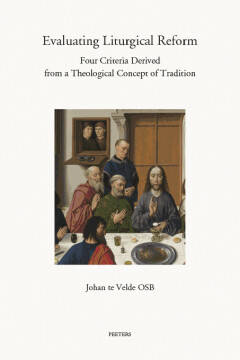
Vous voulez être sûr que vos cadeaux seront sous le sapin de Noël à temps? Nos magasins vous accueillent à bras ouverts. La plupart de nos magasins sont ouverts également les dimanches, vous pouvez vérifier les heures d'ouvertures sur notre site.
- Retrait gratuit dans votre magasin Club
- 7.000.000 titres dans notre catalogue
- Payer en toute sécurité
- Toujours un magasin près de chez vous
Vous voulez être sûr que vos cadeaux seront sous le sapin de Noël à temps? Nos magasins vous accueillent à bras ouverts. La plupart de nos magasins sont ouverts également les dimanches, vous pouvez vérifier les heures d'ouvertures sur notre site.
- Retrait gratuit dans votre magasin Club
- 7.000.0000 titres dans notre catalogue
- Payer en toute sécurité
- Toujours un magasin près de chez vous
Evaluating Liturgical Reform
Four Criteria Derived from a Theological Concept of Tradition
J Te Velde
84,00 €
+ 168 points
Description
If we understand the liturgy of the Church as a form of tradition, how can a theological concept of tradition then contribute to the development of evaluation criteria for reforms of the liturgy? In other words: how can we make the concept of tradition productive for the evaluation of the process of liturgical renewal? In order to be able to formulate a satisfactory answer to this question, the first half of this study offers a number of theoretical explorations on liturgical reform, on a theological concept of tradition that is expressed in liturgy, on the factors that disrupt or aid liturgical communication, and on criteria for evaluating liturgical reforms. The second part comprises six case studies, in which the theory that has been developed is tested. Throughout this work it becomes clear that liturgy in itself is the process of transmitting the person and message of Jesus, in which the Spirit of God and the human person work together indivisibly. The case studies in the second part of this book, concerning the liturgical reform of Vaticanum II, lead to such questions as: Was the traditional nature of the liturgy and its reform sufficiently taken into account? Should the intended changes not have been introduced over the course of a much longer period of time, for instance multiple generations, in order to give the process of tradition with its aspects of maturation, reception, and correction sufficient opportunity? Was the principle of the identity of the liturgy of a rite throughout time given sufficient consideration? Was there enough attention for the sometimes irrational nature of liturgical communication, which is partly a consequence of its traditional nature?
Spécifications
Parties prenantes
- Auteur(s) :
- Editeur:
Contenu
- Nombre de pages :
- 354
- Langue:
- Anglais
- Collection :
- Tome:
- n° 84
Caractéristiques
- EAN:
- 9789042949812
- Date de parution :
- 24-10-22
- Format:
- Livre broché
- Format numérique:
- Trade paperback (VS)
- Dimensions :
- 160 mm x 240 mm
- Poids :
- 10378 g







